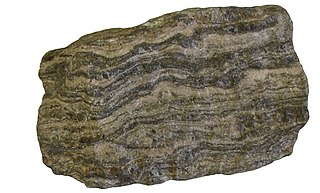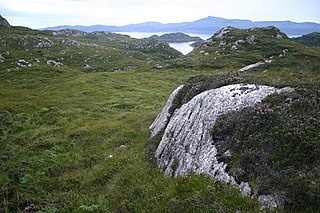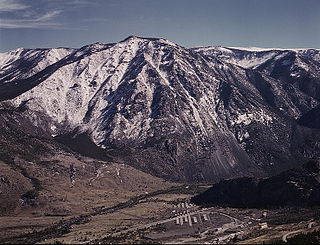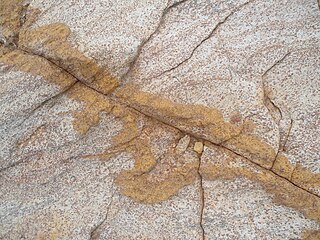Related Research Articles

Gneiss is a common and widely distributed type of metamorphic rock. Gneiss is formed by high-temperature and high-pressure metamorphic processes acting on formations composed of igneous or sedimentary rocks. Orthogneiss is gneiss derived from igneous rock. Paragneiss is gneiss derived from sedimentary rock. Gneiss forms at higher temperatures and pressures than schist. Gneiss nearly always shows a banded texture characterized by alternating darker and lighter colored bands and without a distinct foliation.

Schist is a medium-grade metamorphic rock formed from mudstone or shale. Schist has medium to large, flat, sheet-like grains in a preferred orientation. It is defined by having more than 50% platy and elongated minerals, often finely interleaved with quartz and feldspar. These lamellar minerals include micas, chlorite, talc, hornblende, graphite, and others. Quartz often occurs in drawn-out grains to such an extent that a particular form called quartz schist is produced. Schist is often garnetiferous. Schist forms at a higher temperature and has larger grains than phyllite. Geological foliation with medium to large grained flakes in a preferred sheetlike orientation is called schistosity.

Metamorphic rocks arise from the transformation of existing rock types, in a process called metamorphism, which means "change in form". The original rock (protolith) is subjected to heat and pressure, causing profound physical or chemical change. The protolith may be a sedimentary, igneous, or existing metamorphic rock.

A rock is any naturally occurring solid mass or aggregate of minerals or mineraloid matter. It is categorized by the minerals included, its chemical composition and the way in which it is formed. Rocks are usually grouped into three main groups: igneous rocks, metamorphic rocks and sedimentary rocks. Rocks form the Earth's outer solid layer, the crust, and most of its interior, except for the liquid outer core and pockets of magma in the asthenosphere.

Migmatite is a composite rock found in medium and high-grade metamorphic environments. It consists of two or more constituents often layered repetitively; one layer was formerly paleosome, a metamorphic rock that was reconstituted subsequently by partial melting; the alternate layer has a pegmatitic, aplitic, granitic or generally plutonic appearance. Commonly, migmatites occur below deformed metamorphic rocks that represent the base of eroded mountain chains, commonly within Precambrian cratonic blocks,

Volcanic rock is a rock formed from lava erupted from a volcano. In other words, it differs from other igneous rock by being of volcanic origin. Like all rock types, the concept of volcanic rock is artificial, and in nature volcanic rocks grade into hypabyssal and metamorphic rocks and constitute an important element of some sediments and sedimentary rocks. For these reasons, in geology, volcanics and shallow hypabyssal rocks are not always treated as distinct. In the context of Precambrian shield geology, the term "volcanic" is often applied to what are strictly metavolcanic rocks. Volcanic rocks and sediment that form from magma erupted into the air are called "volcaniclastics," and these are technically sedimentary rocks.

Petrology is the branch of geology that studies rocks and the conditions under which they form. Petrology has three subdivisions: igneous, metamorphic, and sedimentary petrology. Igneous and metamorphic petrology are commonly taught together because they both contain heavy use of chemistry, chemical methods, and phase diagrams. Sedimentary petrology is, on the other hand, commonly taught together with stratigraphy because it deals with the processes that form sedimentary rock.

The lithology of a rock unit is a description of its physical characteristics visible at outcrop, in hand or core samples, or with low magnification microscopy. Physical characteristics include colour, texture, grain size, and composition. Lithology may refer to either a detailed description of these characteristics, or a summary of the gross physical character of a rock. Examples of lithologies in the second sense include sandstone, slate, basalt, or limestone.

A shield is a large area of exposed Precambrian crystalline igneous and high-grade metamorphic rocks that form tectonically stable areas. These rocks are older than 570 million years and sometimes date back 2 to 3.5 billion years. They have been little affected by tectonic events following the end of the Precambrian, and are relatively flat regions where mountain building, faulting, and other tectonic processes are minor, compared with the activity at their margins and between tectonic plates.

Charnockite is applied to any orthopyroxene-bearing quartz-feldspar rock, formed at high temperature and pressure, commonly found in granulite facies metamorphic regions, as an end-member of the charnockite series.

Essexite, also called nepheline monzogabbro, is a dark gray or black holocrystalline plutonic igneous rock. Its name is derived from the type locality in Essex County, Massachusetts, in the United States.

A pelite or metapelite is a metamorphosed fine-grained sedimentary rock, i.e. mudstone or siltstone. The term was earlier used by geologists to describe a clay-rich, fine-grained clastic sediment or sedimentary rock, i.e. mud or a mudstone, the metamorphosed version of which would technically have been a metapelite. It was equivalent to the now little-used Latin-derived term lutite. A semipelite is defined in part as having similar chemical composition but being of a crystalloblastic nature.

In geology, basement and crystalline basement are the rocks below a sedimentary platform or cover, or more generally any rock below sedimentary rocks or sedimentary basins that are metamorphic or igneous in origin. In the same way, the sediments or sedimentary rocks on top of the basement can be called a "cover" or "sedimentary cover".

The Stillwater igneous complex is a large layered mafic intrusion (LMI) located in southern Montana in Stillwater, Sweet Grass and Park Counties. The complex is exposed across 30 miles (48 km) of the north flank of the Beartooth Mountain Range. The complex has extensive reserves of chromium ore and has a history of being mined for chromium. More recent mining activity has produced palladium and other platinum group elements.

Igneous rock, or magmatic rock, is one of the three main rock types, the others being sedimentary and metamorphic. Igneous rock is formed through the cooling and solidification of magma or lava.

Khondalite is a foliated metamorphic rock. In India, it is also called Bezwada Gneiss and Kailasa Gneiss. It was named after the Khond tribe of Odisha and Andhra Pradesh because well-formed examples of the rock were found in the inhabited hills of these regions of eastern India.
The geology of Malawi formed on extremely ancient crystalline basement rock, which was metamorphosed and intruded by igneous rocks during several orogeny mountain building events in the past one billion years. The rocks of the Karoo Supergroup and newer sedimentary units deposited across much of Malawi in the last 251 million years, in connection with a large rift basin on the supercontinent Gondwana and the more recent rifting that has created the East African Rift, which holds Lake Malawi. The country has extensive mineral reserves, many of them poorly understand or not exploited, including coal, vermiculite, rare earth elements and bauxite.
The geology of Libya formed on top of deep and poorly understood Precambrian igneous and metamorphic crystalline basement rock. Most of the country is intra-craton basins, filled with thick layers of sediment. The region experienced long-running subsidence and terrestrial sedimentation during the Paleozoic, followed by phases of volcanism and intense folding in some areas, and widespread flooding in the Mesozoic and Cenozoic due to a long marine transgression. Libya has the largest hydrocarbon reserves in Africa, as well as deposits of evaporites.
The geology of Bhutan is less well studied than many countries in Asia, together with the broader Eastern Himalayas region. Older Paleozoic and Precambrian rocks often appear mixed together with younger sediments due to the Himalayan orogeny.
Microlites are minute crystals in an amorphous matrix. In igneous petrology, the term microlitic is used to describe vitric matrix containing microscopic crystals. Microlitic rocks are a type of hypocrystalline rocks. Unlike ordinary phenocrysts, which can be seen with little or no magnification, microlites are generally formed in rapidly cooled (quenched) basaltic lava, where cooling rates are too high to permit formation of larger crystals.
References
- ↑ "Rocks can be are classified in three types on the basis of their texture and the process of formation i.e. igneous, sedimentary and metamorphic rocks. The igneous rocks are formed when molten lava from a volcano cools down. These rocks are also known as primary rocks as they are the first to be formed and are further of two types: extrusive and intrusive." https://www.learnnext.com/nextgurukul/wiki/concept/CBSE/VII/Geography/Rocks-and-Minerals.htm
- ↑ Webster's Revised Unabridged Dictionary, published 1913 by C. & G. Merriam Co. Cited in: http://www.thefreedictionary.com/Primary+rocks
- ↑ McGraw-Hill Dictionary of Scientific & Technical Terms, 6E, Copyright © 2003 by The McGraw-Hill Companies, Inc. Cited in: http://encyclopedia2.thefreedictionary.com/Primary+rocks
- ↑ "On the Origin of Eruptive and Primary Rocks", Thomas Macfarlane: Part 1 p. 295 XXIII, Part 2 p. 329 XXV, Part 3 p. 457 XXXI.
- ↑ "Report on Country in the Neighborhood of Lake Eyre", H.Y.L. Brown; Bristow (1892): p. 2.
- ↑ Naumann, C.F.; Lehrbuch der Geognosie (2 vols. and atlas, 1849–1854, ed. 2, 1858–1872): https://catalog.hathitrust.org/Record/009800307
- ↑ Gold, Thomas; The Deep Hot Biosphere; Springer Verlag New York Inc. (1999): p. 107.